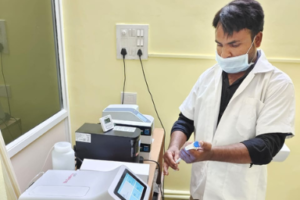Welcome
Consultant Endocrinologist SRINAGESH DIABETES, THYROID, AND ENDOCRINE CLINIC
Dr. V. Sri Nagesh is one of the best Endocrinologists in Hyderabad with more than 10 years of experience in Endocrinology. He is presently working at Sri Nagesh Diabetes, Thyroid & Endocrine Clinic at Tolichowki.

Our Facilities
Complete Diabetes Care Hormone Lab
Routine Biochemistry
Lifestyle Services
PCOS clinics
Dietitian service
Low cost pharmacy
CGMS.
Our Location
8-1-351/A/15, 1st FLOOR, ABOVE KUSHAL FLOWERS, TOLICHOWKI MAIN ROAD, opposite ICICI BANK AND GALAXY THEATRE, Hyderabad, Telangana 500008, India

Dr. V Sri Nagesh is a renowned Endocrinologist in Hyderabad.
He is presently working at Sri Nagesh Diabetes, Thyroid & Endocrine Clinic at Tolichowki. He has also worked as the Assistant Professor of Pediatrics at the Osmania Medical College and has practiced as Adult and pediatric endocrinologist and diabetologist for the past 10 years. Dr Sri Nagesh pursued his MBBS from the Gandhi Medical College. Later on, he completed his MD in Pediatrics from Osmania Medical College. He further completed his super-specialist DM training in Endocrinology from 2009 – 2012 from Osmania Medical College.
Dr. Nagesh has proven his expertise in the field of Endocrinology and his areas of interest include Diabetes, Thyroid, Pediatric endocrinology, PCOS and endocrine genetics.
4.9
1860 Reviews
4.9
Positive comments
4.9
2100 Reviews
Our Expertise

PUBERTY & DEVELOPMENT
Precocious puberty is when a child’s body begins changing into that of an adult (puberty) too soon.

PREGNANCY DIABETES
Gestational diabetes raises your risk of high blood pressure, as well as preeclampsia.

PCOS
Women with PCOS may have infrequent or prolonged menstrual periods or excess male hormone (androgen) levels.
Why People Trust Us
Sri Nagesh Clinic a Centre for Excellence in Diabetes and Endocrinology. We are one of the best diabetes clinics in India with top dialectologists, endocrinologists, dieticians and diabetes educators.
Vision
We aim to provide excellent clinical and compassionate care to our patients. We like to be innovative and offer all our patients with advanced evidence-based care in diabetes and endocrine disorders.
Mission
Our aim is to separate endocrine and diabetes care from “hospital settings” by providing a relaxing environment for the patients considering almost 95% of these patients do not need hospital care but more of a homely atmosphere and personal touch.
AIM
We are committed to offer all the facilities pertaining to Diabetes and Endocrine care under one roof including lab investigations. It is our endeavor to provide investigations at affordable rates that are at par with diagnostic center’s rather than corporate hospitals.
Our Treatments
• Diabetes Treatments • Thyroid Treatments • Reproductive Endocrinology • Male Sexual Disorders • Adernal Disorders • Metabolic Bone Diseases • Endocrine Disorders • Pediatric Endocrinology • Pituatary Disorders • Parathyroid Disorders
What People Say About Us

Srinivas
“Dr. V. Sri Nagesh is extremely knowledgeable and does a great job managing my disease states. I never feel rushed and I always have all of my questions answered. The support staff is wonderful as well.”




Address
8-1-351/A/15, 1st FLOOR, ABOVE KUSHAL FLOWERS, TOLICHOWKI MAIN ROAD, opposite ICICI BANK AND GALAXY THEATRE, Hyderabad, Telangana 500008, India
Call Us
+91 984 9878 091
040-23565223
Email Us
srinageshclinic@gmail.com







